Cinematography:
At the beginning of the fig tree sequence, the camera pans to the right to follow the movement of the soldiers rushing into the woods. This shows that they are the dominant force in this moment and keeps the audiences attention on them. The movement of the soldiers and Ofelia’s are also from the left side of the screen to the right, implying a journey on both sides of the story. We then cut to Ofelia and the shot has her in frame to show that she is the centre of her side of this scene, and also that she is running away from the mill. It also stays at her eye-level, putting us in her position and creating relatability and empathy in the audience for Ofelia.We cut back to the Captain and see the camera rapidly pushing past trees to keep up with him and his horse. This creates a fast pace and feeling of movement, and how fast he is moving, and brings the audience into the scene. A wide shot quickly crabs to the right to show that he is ahead of the rest of the soldiers, showing his position at the heads of authority, and his obsession to find the rebels. It also shows how many men he has under his command, and how loyally they follow him into danger, displaying his power and control.
After cutting back to Ofelia, a low-angle shot shows how small she is compared to the rest of the woods, and therefore the daring of her quest, and therefore the danger that she is in. the shot after this one is a high-angle until Ofelia approaches and nears the camera. It then becomes a mid-shot to show that Ofelia is looking out into the woods in adventure. The movement of the camera also keeps the pace going and immerses the audience, making them feel less like an observer to the events in the film but that they are actually in the film, involved in what’s going on.
The camera then arches around her to reveal the tree she is looking for. It also begins to tilt upwards to reveal the full scale of the tree and its scale in comparison to Ofelia, implying how much danger she is in and also framing it like a dominant building, making it feel more intimidating and imposing, like its in control of the environment around it. This also show’s that Ofelia is not at all afraid of the tree, and in the face of mysterious and possibly dangerous forces she is only overcome with curiosity and child-like joy, not fear or apprehension.

A glance object show’s what she is holding, stones, and this temporary focus on them signifies their importance to the plot. There is also a glance-object of her shoes. This could be a foreshadow to the shoes he gains later on in the film, but here it is primarily for the purpose of signifying how rotten and in-clean this environment around and inside the tree is. A wire shot then brings the camera up to bring the branch into frame, keeping focus on Ofelia and it to show what her expression is like, showing that she has noticed, and what has captured her interest, signifying its importance in this scene.
The camera pulls backwards and pedestals upwards via crane shot to reveal the dress. This shot establishes that Ofelia is now heading straight into the danger, and the dress in kept centre frame to show that it is important that it is placed there, and foreshadows that it will play a part in the film later on, which it does. As Ofelia crawls through the tunnel we cut back to Vidal via hidden cut, but she and him are still moving from left to right, showing a nearing end to their journeys. The lighting in the tunnel is also dark and gloomy, creating an unsafe and uncertain atmosphere, but the lighting is bright enough for us to see Ofelia’s face, keeping her expression clear and visible to the audience. After cutting back to Vidal’s side of the scene, we see a close-up of his boots hitting the floor to establish that he has confident footing, and the force with which he hits the ground signals his intensity and aggressiveness. The camera also follows him and keeps Vidal centre frame to maintain him as the focus of this scene.
There is a glance-object of the fire to create a connection between what Vidal is thinking and why he has come to the conclusion that the rebels are still nearby. The camera then pedestals up and arch’s around the Captains head to show his thought process and also keeps the other soldier in frame, but not at the centre, to show his loyalty to the Captain and show to them audience that he is not saying anything important in this moment. The camera pushes in slowly to show that Vidal has noticed something. A glance-object show’s what he has noticed and the fact that this is important to the Captain, holding the viewer’s attention as an important plot device is revealed.
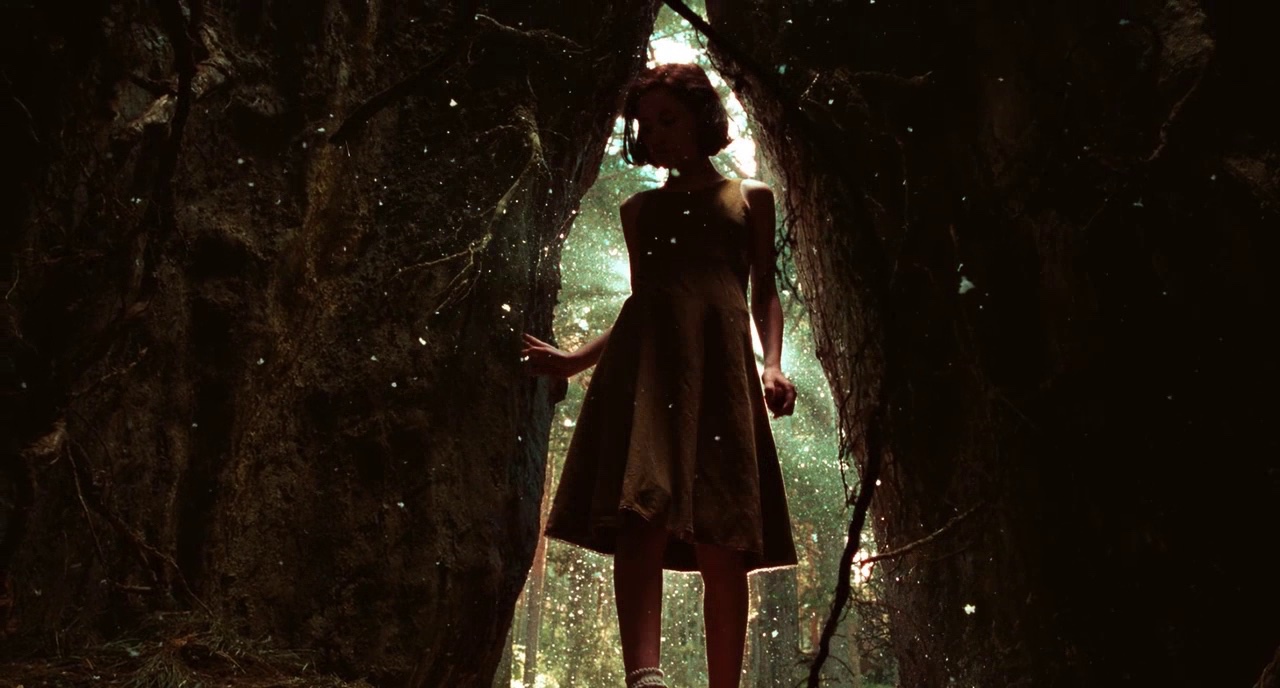
The antibiotic bottle is kept centre-frame in the close-up shot as the Captain lifts it up to make it obvious to the audience what it is, and why it is important. The Captain himself is also kept centre-frame to keep the audience’s attention on him and his movements. As Vidal shouts into the woods, the camera is positioned in a low-shot from behind him to show where he reckons the rebels are and where he is shouting at, and then a high-angle wide-shot shot from in front of him shows the size of the forest and emphasises that the rebels could be anywhere, building suspense, and also making the audience question whether this shot is from the perspective from the rebels or not. An extreme close up of Vidal then Showa how intense and obsessed Vidal is to the cause of destroying the rebels.
When the rebels are finally revealed, they are all kept in a wide-shot which shows how many there are and how they are all glaring at the soldiers after they retreat. After we cut back to Ofelia, who is now crawling through the tunnel, she, like Vidal was, is kept centre-frame to keep our attention on her and her reaction to the environment around her. A long-shot of the hallway creates suspense, and the camera slowly pushing in creates the feeling os claustrophobia and makes the atmosphere more tense, making us wonder in fear where the danger is coming from and what it will look like.
the toad is revealed by the camera moving from Ofelia to the shot in a single take, building suspense and slowly bringing the toad into frame, showing what it looks like, where it is, and how Ofelia reacts to it. There is then an over-the-shoulder shot from behind the toad, which personify it, adding to the fantasy element of the scene, and also showing how much bigger it is than Ofelia. After the toad licks Ofelia’s face, we see a close-up of her hand that also serves as a match on action to signify that she has dropped the stones, and that this is about to have an important consequence to the scene.
A match-on-action shows her picking them up, and then a wide-shot is done to show how far the toad is from Ofelia, and therefore the power of the burp. The way that the edges of the frame are also covered by mud adds to the feeling of being trapped, immersing the viewer in Ofelia’s situation. The camera then cut’s to a close-up of Ofelia’s hand to show what she has picked up and how this is important. After the toad has died, the camera follows Ofelia to build suspense as she approaches the key, and keep the audience immersed in the moment as a participant in the story, not just a mutual bystander, since we see the key at the same time she does. As she crawls towards the key, we see what it is, and by keeping Ofelia in frame we see that it is her objective to obtain. The key is then kept centre frame, like the antibiotic bottle earlier, to show its importance to the plot and the character. There is then a close-up of Ofelia after she escapes the tree to show how tired and exhausted she is. It also tracks her movements and moves the right enough to reveal that she has lost the dress, and establish the trouble she faces now. The camera also moves back to eye-level to create sympathy for her as she realises the trouble that she is in.
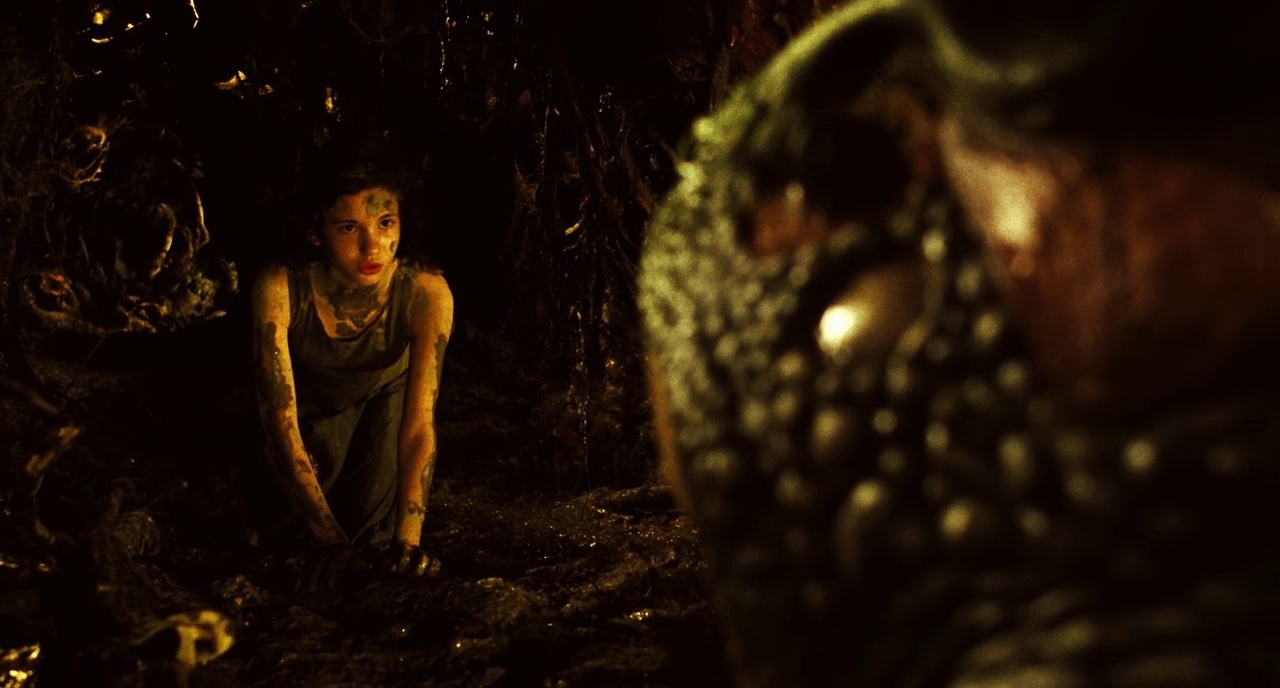
Sound:
As Vidal and his troops leave the mill, the non-diegetic score immediately picks up into an intense and dramatic orchestral tone which is emphasised by trumpets and other horn instruments signalling a grand arrival but with a dark undertone, indicating the power of the men but also their dark and immoral motives. The diegetic sounds also increase suddenly as the scene is quickly filled with the sounds of multiple horse hooves, neighing and the shouts of men. This immerses the audience and also emphasises the intensity of the moment., and the speed and purpose with which the men are moving.
the trumpets decrease in tone and pitch as we cut to Ofelia, but does not put the scene in complete silence as the heroic and exiting tune keeps playing, keeping the audience’s attention and focus on the scene, and not losing the fat and aggressive pace. However we can still hear the muffles and distant sounds of men and horses as we are with Ofelia which immerses us in the setting and makes it feel more realistic. It also establishes that Ofelia and Vidal are leaving the mill at the same time, making the rest of the sequence parallel editing. The contrast between the aggressive and dramatic music that plays when Vidal is on screen and the bright and peaceful and heroic music that plays for Ofelia contrasts their characters.
As Ofelia walks through the forest, we hear the sounds of mud and rustling beneath her feet. This immerses the audience in the setting of the scenes, so even something as small as ambient diegetic sounds can contribute to how much the audience is attached to a scene and environment in a film, including the stones in her hand, which signifies their importance. After reaching the tree, a dramatic horn sound picks up in the mix to foreshadow that something is wrong, and that danger is possibly approaching. This keeps the audience invested and on the edge of their seats and building suspense, and also adds a dark and serious atmosphere to the scene.
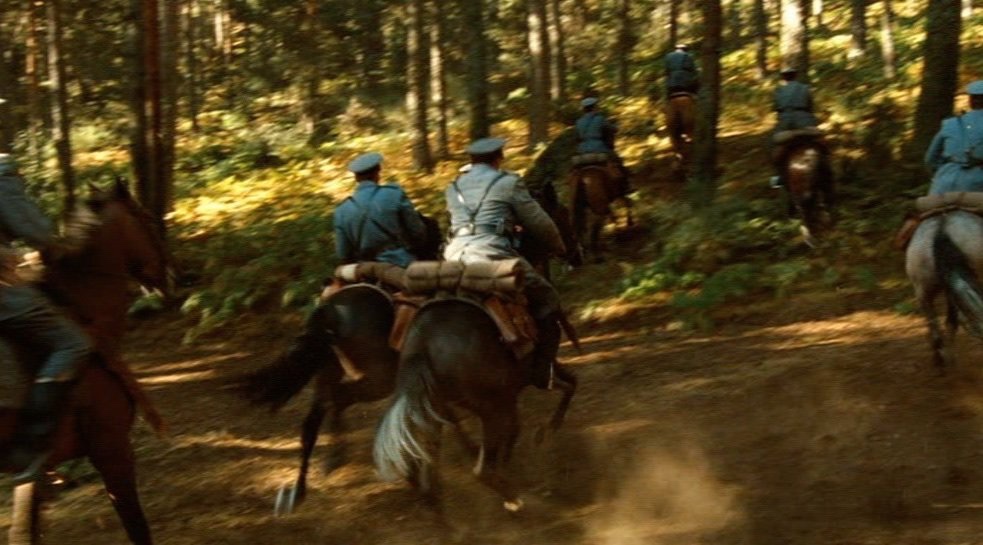
As the camera pushes in on the dress, the diegetic sound of wind picks up in the sound mix to signify that something bad is going to happen to the dress, a foreshadow and an explanation for when the dress is found on the ground later on. As we cut to Ofelia inside the tree, the diegetic sounds are muffled and distant, as if from underwater, which creates a tense and uncomfortable environment and atmosphere in the tree, and puts us in Ofelia’s position. A low violin sound picks up in the non-diegetic composed score to signify a tragic aspect of the scene, creating suspense and fear for Ofelia’s safety. A sound of wind rushing also creates a cold and un-safe atmosphere as Ofelia enters the tree and signifies a change into the fantasy world again.
After cutting back to Vidal, the sound of the horses slowly disappears as they leave frame to reduce the sound in the mix, keep the pace slow and calm, and make space for the audience to pay attention to Vidal and what he is saying. The loud and powerful sound of Vidal’s boots hitting the floor temporarily drowns out all others in the sound mix, showing how much authority and dominance the Captain holds over the scene when he is in it.
As he investigates the campsite, we can hear the diegetic sounds of birds tweeting in the forest. These calming and peaceful sounds keep the pace of the scene slow and patient but also prevents the scene from being too quiet as Vidal looks around. It lets us hear his words, immerses us in the scene, and builds suspense without leaving the scene in complete silence. It also contrasts the constipated and muffled sounds of the inside of the tree, helping the viewer adapt to the new setting.
As the Captain shouts into the woods, his voice echoes throughout the trees to shown that the rebels most likely heard him, how truly massive the woods are, and how commanding and intimidating the Captain is. It also implies that even the creatures of the forest cannot escape the influence of the Captain. As we cut to a close-up of Vidal, horn instruments pick up suddenly and sharply in the score again. This subtly symbolises his mounting frustration and disdain for the rebels, and also creates the feeling of fear from something as simple as the look he makes in this moment. The music also builds up to a dramatic reveal of the rebels, and build into a climax as the scene cuts back to Ofelia. The way that the music suddenly cuts out here implies that the scene will be following here from now on.
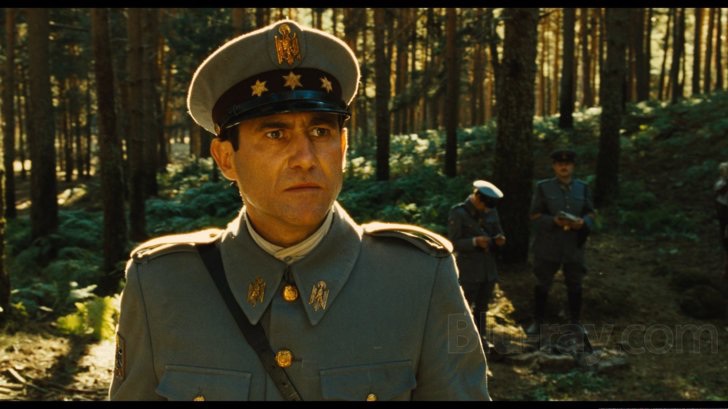
A low and guttural sound emerges in the diegetic sound mix as hits shot of the tunnel continues which builds tension and implies that something large and powerful, possibly dangerous is nearing, building tension and suspense, and therefore keeping the audience’s attention. Once the toad enters frame, it produces deep and rough, wet and moist sounds. These make the audience uncomfortable and evokes disgust in them for the toad. As the camera gets closer to it, the sounds increase in pitch and volume, making the audience more repulsed by the creature and again making them feel more like an actual participant in the movie as opposed to a bystander only witnessing the events.
When the toad burps, the diegetic sounds in the mix massively pick up and the roaring noise overcomes all others. This establishes the toad as a powerful and imposing creature that seems to have dominion over this territory. This moment disturbs the audience and raises the stakes as we now understand that Ofelia is in danger.
After Ofelia picks up the beetle it uncurls itself, and as it does he hear the diegetic sound of scuttling. This makes the insect seem more alive and biotic than a CGI monster, and also establishes to the audience that it is an object of significance in that moment. The score picks up into a hopeful and calm toned moment that signals to the audience that Ofelia has noticed something, as shown in the previous shot, and the music shows that this has led her to a realisation.
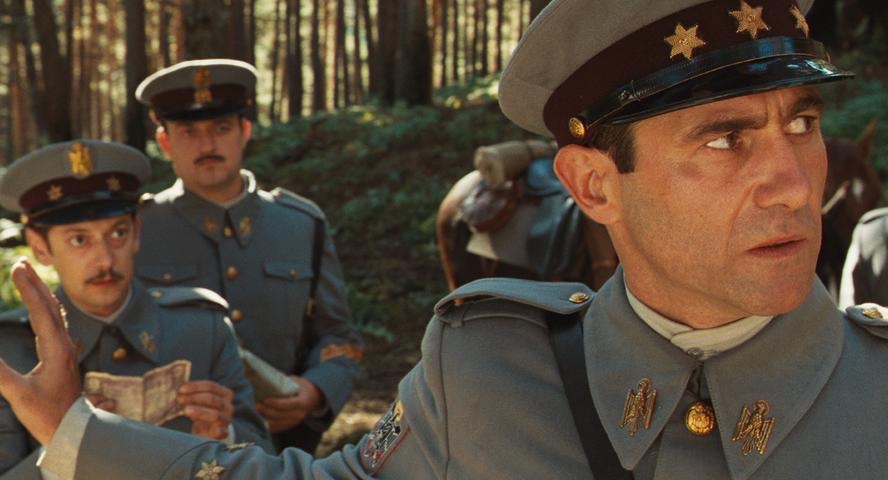
When the tongue shoots out from the toads moth, we hear a loud roaring and squelching sound that makes this fantasy creature seem more real and organic, adding a realistic and serious tone to the fairy-tale monster, as if done again in the film later on. As the toad dies, we once again hear roaring but also a cracking sound to match the image of the toad’s jaw unhinging as it dies, adding to the gore of the moment. As its corpse deflates we hear a sound like rushing air, and as Ofelia retrieves the key from the contents of it’s stomach we hear sticky squelching. These diegetic sounds act as an audible sort of mise-en-scen, making the scene feel more real, immersing us by putting us in Ofelia’s position, and making the scene feel more real by adding to the texture of the objects on screen. Non-diegetic sounds also signify items as important though, as seen, or rather heard, when Ofelia picks up the key and a sharp ringing sound emerges in the mix, focusing the viewer’s attention on it.
We again hear wet and sticky sounds as Ofelia wipes her forehead to emphasise just how in-clean she is, creating sympathy in the audience for her, and making them think about just how much she has been through. We are introduced to the new setting outside of the cramped and claustrophobic environment of the tree to the the open and spacious forest by the sound of Ofelia’s footsteps crunching on the leaves beneath them. The distant thunder hints towards the coming thunderstorm, building suspense and an impending feeling of danger and fear for Ofelia.
Editing:
The first hidden cut in the scene is made when the camera moves behind a tree and when it emerges on the other side we are with Ofelia. This serves as a seamless transition that keeps the pace of the scene going and is hard to notice, linking the left to right movement of the characters between shots, and making the transition less jarring and distracting than an ordinary cut.
The scenes are established as parallel since we know that Ofelia and Vidal leave the mill at the same time, and the mid-day lighting implies that these events are happening at the same time. The locations of the different parts of the forest being similar also makes the movement of the scene feel more seamless and more like an uninterrupted sequence and experience of the events on screen. The hidden cuts are also used to keep in the audiences mind that the scenes are taking place parallel to each other. Another hidden cut is made from behind another tree to keep the fast-paced scene of horse-riding not lead to a sudden cut to the more calm and measured scene of Ofelia walking in the woods alone. It also signifies that both characters are approaching their destinations/goals in this moment.
Another hidden cut changes the position of the camera and signifies a passage of time between the cut. Every time a hidden cut is made the characters are kept centre-frame to keep them as the centre of the audience’s attention and they are also moving in the same direction, creating a similarity between both scenes and therefore a seamless transition that keeps the pace going smoothly and not suddenly cutting between shots. Once Ofelia reaches the tree there are no more hidden cuts. This is done to slow the pace of the scene and build suspense without cutting back to Vidal. This is continuity editing, since the lack of hidden cuts allows for the scene to play out before us in-interrupted, letting the audience follow the scene with clarity thanks to the continuity and lack of transitions.
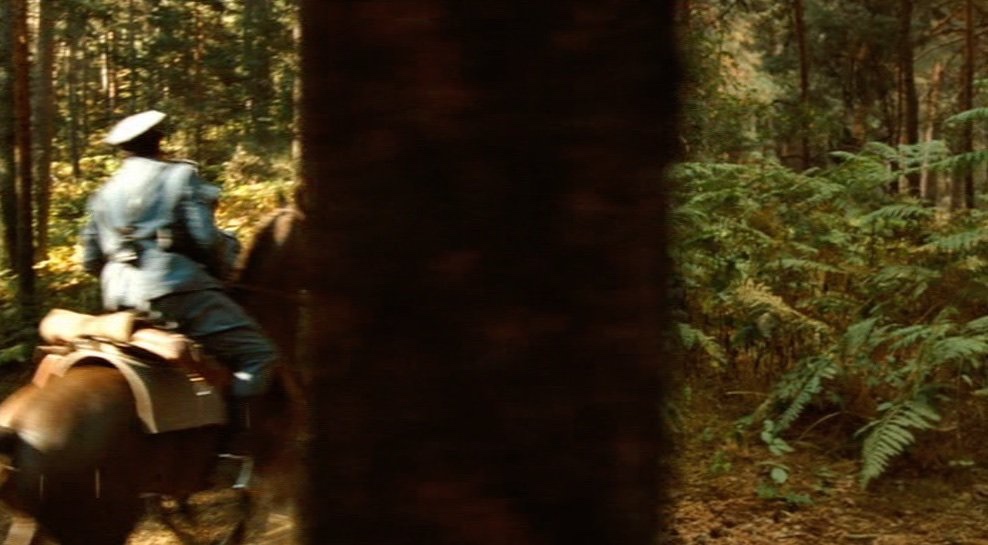
After Ofelia enters the tree, a hidden cut is made from the tunnel to a tree, and from there we are following Vidal again, making the change again smooth and not at all surprising, since it has been done before in the scene and the audience has a slit second more than they would with a normal cut to interpret the new environment of the scene. It also keeps hold on the audience’s attention throughout the scene, keeping them involved in the story and immersed in the. narrative.
The camera only does another hidden cut from behind a tree to show a passage of time, as the horses are further away afterwards, and change the position of the camera to where the rebels are standing, revealing where they were watching from all along. The scene does not do a hidden transition back to Ofelia to imply that the scene will be following her from now on.
As Ofelia talks to the toad, there are shot-reverse-shots that personify it, and therefore make it feel like a much more real and organic creature, making the audience question whether or not it is all in Ofelia’s imagination. It also makes for room to show off how large and indifferent the toad is to Ofelia, making the audience concerned but also fascinated in the huge monster on screen.

Mise-en-scen:
Ofelia’s outfit is quaint and simple, a clear reference to typical fairy-tale protagonists who were from humble beginnings and would wander off into the woods on some grand quest, as she does in this scene. It also looks similar to Alice from Alice in Wonderlands dress, creating a link between the two characters, and their story’s. The book she is reading is large and antique, signifying the grand scale and ancient legend of her stories, and the one that she herself is creating.
The tree, once it enters frame, is large, old and rotten. This adds to the still a new tense atmosphere of the scene, and making is teem much more imposing and intimidating than the other trees in the forest, and matching the description of the fairy-tale, giving the first grain of truth to the seemingly childish story. The entrance is shrouded in darkness, making it seem feel more mysterious and dangerous, and creating fear in the viewer for Ofelia’s safety. The tree itself is also shaped like a uterus, adding tonic themes to the film by serving as hidden imagery/symbolism to create deeper and subtler messages in the film. The ribbon that flys off the dress foreshadows the affect that the wind will have on the dress later on.
As Ofelia enters the tree there can be seen dusty particles in the air, giving the scene a surreal and fairy-tale like atmosphere, and thereby immersing the audience in the setting of the tree, and making it easier to understand what Ofelia is going through, literally! The inside of the tree itself in completely coated in mud and dirt, infested with large and unsettling insects, cramped by withering branches. This setting is uncomfortable for the audience to see, and the other aspects of the scene, especially cinematography and sound, make us feel out of place and nervous as Ofelia explores it, showing her bravery and bringing to life these ancient grim fairy tales. The mud collecting on Ofelia’s previously neat outfit shows how little she cares about it, and her persistence to drive on, whilst most, if not all, people in the audience would of turned back by now.

As Vidal investigates the fireplace, there is still steam coming off of it, acting as a visual clue that the rebels only recently left. The antibiotic bottle is small and clear, implying that it is valuable and also allowing for the audience to see it clearly. The Uniforms of the soldiers are very straight and clean and also a deep shade of blue, a sharp contrast to the green, in-organised and dirty woods around them, implying that they do not belong there. The gear and weapons they brought with them does indicate their power though, and willingness to commit violence. Their uniforms also contrast and conflict with those of the rebels, which is darker, less done-up and fashionable, like a personification of the woods themselves, and also showing that they are literally more suited and adapt, even in control of the environment of the forest. The weapons are also heavily armed, showing that they, like the Captain, and even though we haven’t seen it yet, are also willing to commit acts of violence for their cause.
Back in the tree, Ofelia now has dried mud on her face, signifying a passage of time. The toad is covered in bumps and rubbery looking skin, with thick and slimy saliva drooling from its mouth. It has long eyelashes and goat eyes, a huge moth and wet and sticky tongue. All of these factors in its physical appearance contribute to it evoking feelings of disgust and repulsion in the viewer, who as a result has a physical reaction to what they before just suspected was a harmless fairy tale, emphasising the real life scale and danger of these stories.
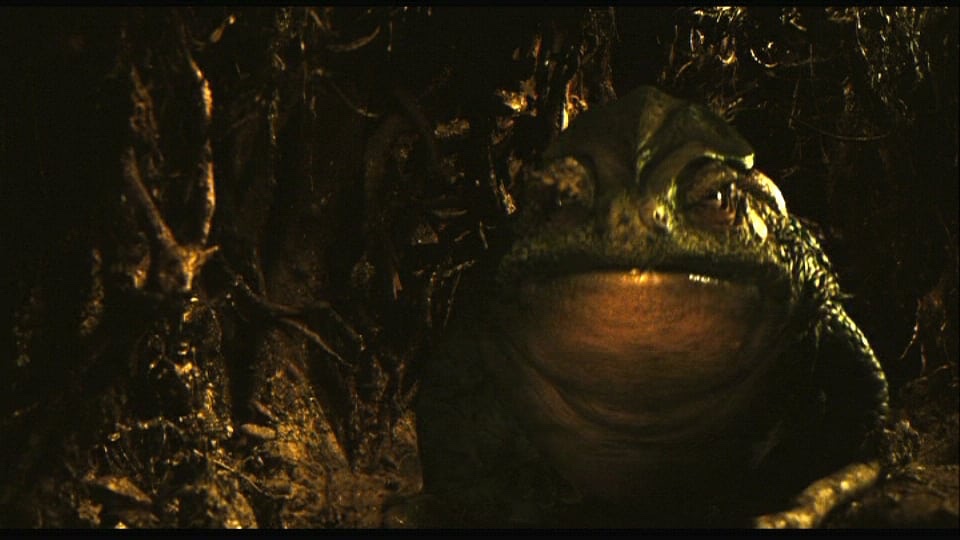
After the toad licks Ofelia’s hand, it is completely coated by slime and muck, making the audience sympathise for Ofelia, but also admire her bravery and lack of fear at this mighty beast, signifying her dedication to become the princess. As the toad deflates, its previously rubbery and wet skin now looks slightly like plastic, or a deflating balloon, instantly reducing the power of the animal and the fear it evoked whilst kit was alive, once again immersing the audience in the reality where the toad is not a reality, and therefore not a threat. In other words, the toad is not as monstrous when it is alive and breathing.
It’s(previously) insides are orange and made of slime, creating more repulsion in the audience as the camera nears it, and ensuring that the disgusting nature of the creature, if not the fear it evoked, is still alive after the toad dies. After Ofelia finally leaves the tree, her hair is completely plastered down by slime, her face covered in mud, and clothes soaked. This creates sympathy for her and the detail of the filth helps for us to imagine how much she has been through and how she feels in that moment.
Performance:
We can tell that Ofelia is running away from the mill from her sudden break into a run after turning back to indicate that she heard the soldiers setting off and momentarily thought that they were after her. She seems curious and full of wonder as she explored the woods, showing her excitement at being a part of the fairy-tales she has read about for so long. She seems cautious as she enters the tree, showing that she knows their could be danger about, but she makes no hesitation as she approaches the tree, indicating her bravery and fascination. As she crawls through the tree, her uncomfortable expression and laboured breathing shows that she is apprehensive and possibly re-considering her depiction tom go this far, but most of her reaction seems to be out of disgust as she studies the tunnel she is in.

The Captain also acts with intense purpose and authority as he approaches the fire, refusing to break his gaze from it, indicating to the audience what is important in this moment. As the Captain holds his hand up, his soldiers instantly silence themselves. This quickly establishes his power and authority over three, their loyalty and the un-caring and in-human nature of the Captain. Vidal seems sure in himself as he assesses the campsite, and even more confident that the rebels are nearby, signifying his skill and experience as a military leader. As approaches the tree line, he once again refuses to break his gaze, making him come across as a sort of un-caring machine, completely obsessed with carrying out its purpose, and shows Vidal’s inner anger and hatred for the rebels. Vidal’s voice as he shouts out into the woods is extremely booming and powerful, assuming control of the entire area around him.
The submissive silence of his men here also shows his authority over them, and his willingness to take charge. His dark and brooding expression hints at the the evil and disturbing things that must go on in Vidal’s mind, and also references the look he made as he killed the two farmers, showing how he always looks that calm yet intent. It also shows how inwardly infuriated he is over being too late to stop the rebels, and that they are probably just out of his reach and sight, but still has enough command to control his emotions, except for when he brutalises innocent people in cuts of um-measured rage, but even that he does with a cool and collected look on his face. There is another sign of his authority as the men instantly follow his suit from a gesture as simple and him holding up his hand. He also does not wait for them to follow him, because he know that they will follow his commands exactly as he says to. Or rather, signals to.
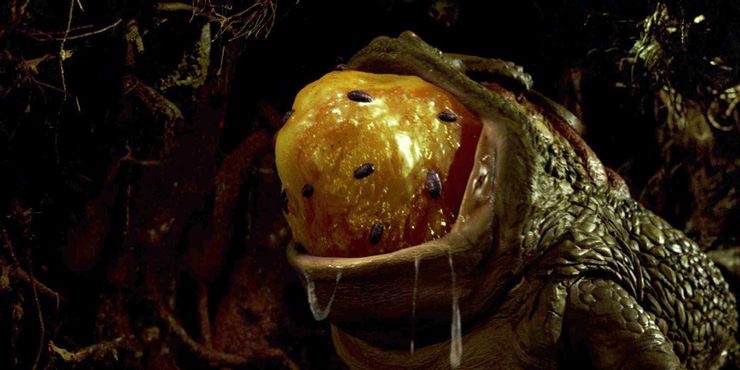
As Ofelia questions the toad, she seems genuinely confused at why it chooses to live down there, showing that she does not question the reality of what she is seeing, but rather the more mundane and simple questions about it. E.G not why is there a giant frog, but rather why he likes to live in the tree. It also shows her childish imagination/wonder and her fearlessness. She does seem concerned when she loses the stones though, keeping in the viewers’ mind that she is still a child, just one mostly concerned with completing a magical quest.
She looks fascinated and even hypnotised as she approaches the key, showing her dedication/devotion to getting it. After leaving the tree, Ofelia wipes her forehead and sighed, breathing heavily and leaning against the tree, emphasising her exhaustion and allowing for the audience to put themselves in her shoes. She also seems more vulnerable once outside of the tree, showing that she is much more comfortable, strangely in the wet and muddy underworld of the fantasy world, rather than the real one where Vidal has the power, signifying that he, a single man, evokes more fear in her than the giant toad and claustrophobic tunnel filled with insects was.
You must be logged in to post a comment.